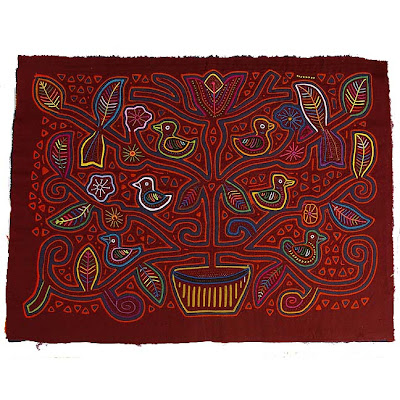We just listed a mola on Etsy that led to some interesting thoughts on creation and connectedness. This mola has a tree on it with a bunch of birds. Perhaps it is just a tree, but we like to think of it as a tree of life. This tree, the tree of life, the tree that sustains, the tree that protects, the tree that gives knowledge or poison, the tree that connects the earth to heaven, yes, this tree, is found in so many cultures and throughout history that one must almost conclude that there is a genetic inprint in our brains. We need this tree.
 Dr. Gail Ramshaw, a scholar of Liturgical language, has had an avid interest in the tree of life. She has documented how it appears in many cultures throughout history around the world and ties it in with our collective psyche. Of the Kuna, she says:
Dr. Gail Ramshaw, a scholar of Liturgical language, has had an avid interest in the tree of life. She has documented how it appears in many cultures throughout history around the world and ties it in with our collective psyche. Of the Kuna, she says:"The Kuna people of the islands near Panama tell of the paluwala tree of life. A creation tree, it flourished at the beginning of time, and all the animals emerged from its branches." So, perhaps in this mola, the birds are emerging, moving to their full potential as the best birds they can be.
 If you are interested in mythology and multiculturalism, do take a moment to read Dr. Ramshaw's essay on the Tree of Life. She approaches it within the context of church life, history and spirituality. There are some interesting insights into some Christian myths which also relate to the Tree of Life. One story tells of how Adam's original tree was a marvellous source for miracles and plentifulness. But, it was cut down and from the trunk Christ's cross was made. But, there are also many references to pagan and other traditions that are also great stories.
If you are interested in mythology and multiculturalism, do take a moment to read Dr. Ramshaw's essay on the Tree of Life. She approaches it within the context of church life, history and spirituality. There are some interesting insights into some Christian myths which also relate to the Tree of Life. One story tells of how Adam's original tree was a marvellous source for miracles and plentifulness. But, it was cut down and from the trunk Christ's cross was made. But, there are also many references to pagan and other traditions that are also great stories.Yet, for Ramshaw, the tree is more than a story, it is the archetypal element that draws the world's religions and imagination together. The following text is from a sermon from the Early Church. Although the context is Christian, the same iconography and life sustaining images are found in other religions:
This Tree is my eternal salvation. It is my nourishment and my banquet. Amidst its roots I cast my own roots deep: beneath its boughs I grow and expand, revelling in its sigh as in the wind itself. Flying from the burning heat, I have pitched my tent in its shadow, and have found a resting-place of dewy freshness. I flower with its flowers; its fruits bring perfect joy - fruits which have been preserved for me since time's beginning, and which now I freely eat. This Tree is a food, sweet food, for my hunger, and a fountain for my thirst; it is a clothing for my nakedness; its leaves are the breath of life. Away with the fig-tree, from this time on! If I fear God, this is my protection; if I stumble, this is my support; it is the prize for which I fight and the reward of my victory. This is my straitened path, my narrow way; this is the stairway of Jacob, where angels pass up and down, and where the Lord in very truth standing at the head.
This Tree, vast as heaven itself, rises from earth to the skies, a plant immortal, set firm in the midst of heaven and earth, base of all that is, foundation of the universe, support of this world of men, binding-force of all creation, holding within itself all the- mysterious essence of man. Secured with the unseen clamps of the spirit, so that, adjusted to the Divine, it may never bend or warp, with foot resting firm on earth it towers to the topmost skies, and spans with its allembracing arms the boundless gulf of space between.
The Buddha sat under a Banyan Tree as he searched for enlightenment. Perhaps the draw for all of us is that when we can see the tree, especially when we zoom in on it with an artistic eye, we recognize that we need it, see more clearly because of it. We can breathe better when there are trees to give us shade.
Take a look outside your window. Do you see a tree? Do you have a favorite? If not, perhaps you need a bit of Kuna love, a mola tree to give you that sacred space our psyche's crave...










